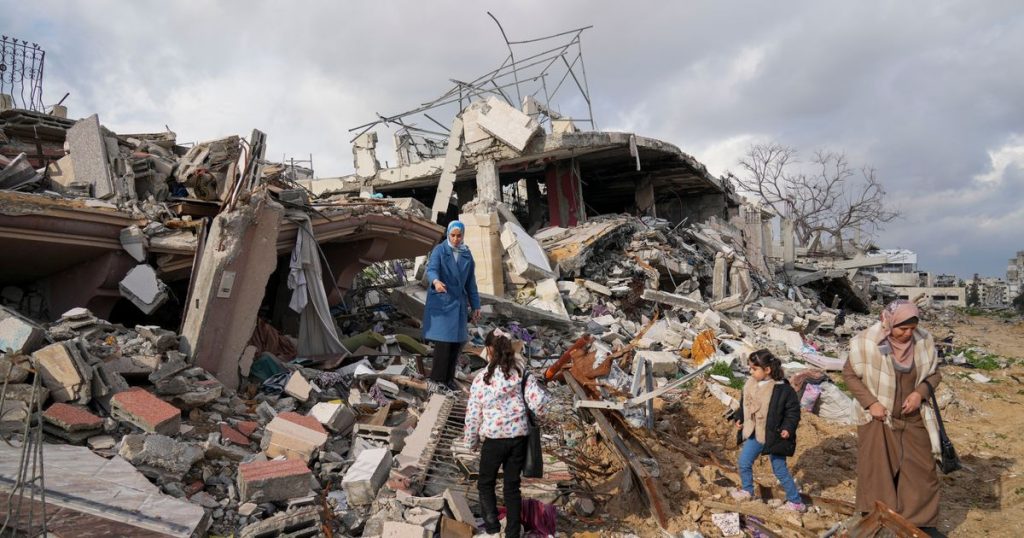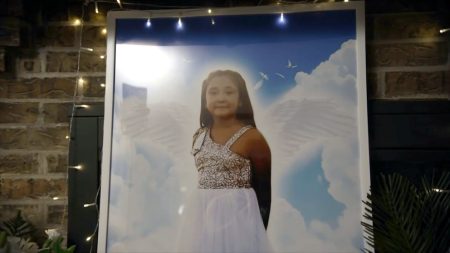Life Amidst the Ruins: The Struggle to Rebuild in Northern Gaza
A Glimpse intoRawia Tambora’s Daily Struggle
When night falls over the war-torn northern Gaza Strip, the landscape of collapsed buildings and scattered debris plunges into darkness. For Rawia Tambora and her young sons, the absence of electricity and running water has turned their home into a fragile refuge. Though they have returned to their house in Beit Lahiya after months of displacement, the structure is a mere shell of its former self—damaged, without basic amenities, and surrounded by rubble. Tambora uses her flashlight and phone light to comfort her children, but the uncertainty of their future weighs heavily on her mind. “My brain stopped planning for the future,” she admits, as the family struggles to survive in a place that feels more like a temporary shelter than a home.
The six-week ceasefire, set to expire soon, has brought a measure of relief to thousands like Tambora, but the reality of living in the wreckage of their lives is daunting. Nearly 600,000 Palestinians have returned to northern Gaza, only to find their homes destroyed or severely damaged. The initial joy of returning has given way to the harsh realization that rebuilding will take years, if not decades. Tambora, like many others, feels trapped in a state of limbo, unsure of what the future holds. With no running water, electricity, or basic services, daily life is a constant struggle. “Some people wish the war had never ended,” she says, reflecting the desperation that has gripped many in the region.
The Cost of Rebuilding: A $53 Billion Challenge
The scale of the destruction in Gaza is staggering. Entire neighborhoods have been reduced to rubble, and the cost of rebuilding is estimated at $53 billion, according to a recent report by the World Bank, the United Nations, and the European Union. The funds required to restore basic infrastructure, let alone rebuild homes and businesses, are astronomical. For now, there is little capacity or funding to initiate significant reconstruction efforts. The priority for many humanitarian agencies is to make Gaza livable in the short term.
The lack of heavy equipment and construction materials has hampered even the most basic efforts to clear rubble and restore essential services. Gaza’s municipality has attempted to fix water lines and clear streets, but with only a fraction of its machinery operational, progress is slow. The U.N. estimates that over 50 million tons of rubble need to be cleared, a task that would take 100 trucks over 15 years. For families like Tambora’s, who are barely managing to survive, the thought of such a long and arduous process is overwhelming.
Meanwhile, humanitarian organizations have stepped in to provide some relief. The U.N. reports that free kitchens, water delivery stations, and the distribution of tents and tarps have been set up across Gaza. These efforts have brought some comfort to displaced families, but they are only temporary solutions. The need for permanent housing and reconstruction remains acute.
The Humanitarian Effort: A Glimmer of Hope
Despite the challenges, there are signs of hope. After threats from Hamas to slow hostage releases unless more aid was allowed into Gaza, Israel agreed to permit the entry of mobile homes and construction equipment. This step, however small, has provided a glimmer of hope for families seeking to rebuild their lives.
Humanitarian agencies have also ramped up their efforts, distributing food and setting up temporary shelters for hundreds of thousands of people. Tambora, who worked as a nurse at the Indonesian Hospital during the war, now commutes an hour each day to work at the Kamal Adwan Hospital. Her 12-year-old son,任务 including fetching heavy water containers and gathering firewood for cooking. While aid has made food more accessible and affordable, the cost of living remains high, and many families are barely scraping by.
For Tambora and her family, the situation is particularly dire. Their home, destroyed in an airstrike early in the war, now consists of a single semi-intact room. The ceiling is partially collapsed, and the walls are cracked. The few remaining appliances, like the fridge and sink, are useless without water or electricity. The family’s belongings are stacked in a corner, and their sense of security is fragile.
voices of Despair and Resilience
The stories of Rawia Tambora and her family are not unique. Across northern Gaza, families are grappling with the aftermath of the war, their lives forever changed by the destruction they have witnessed. Asmaa Dwaima, a 25-year-old dentist from Gaza City, returned to find her family’s four-story home reduced to a pile of flattened and burned wreckage. She had avoided visiting the site for weeks, unable to confront the loss of the home where she had grown up. “They don’t just destroy stone,” she said. “They are destroying us and our identity.”
For Dwaima, the loss is personal and profound. Her family had previously rebuilt their home after it was destroyed in 2014 during another round of fighting between Israel and Hamas. But now, with no funds or materials, they have no means to reconstruct it again. “We need to remove the rubble because we want to pull out clothes and some of our belongings,” she explained. “We need heavy equipment … but there are no bricks or other construction tools, and if available, it’s extremely expensive.”
Dwaima’s story reflects the broader struggle faced by Gaza’s residents. The war has not only destroyed their homes but also their sense of security and hope for the future. Tess Ingram, a spokesperson for UNICEF, has witnessed this firsthand during her visits to northern Gaza. “The families I met are grieving the lives they used to live as they begin to rebuild,” she said. “Their desperation is becoming more intense.”
rebuilding Hope: The Young Generation’s Fight for Normalcy
Amid the devastation, there are stories of resilience and determination. Huda Skaik, a 20-year-old student, shares a small room with her parents and three siblings at her grandparents’ house in Gaza City. Though it is a far cry from their former home, it is an improvement from the tent camps where they were displaced for much of the war. “At least here we have walls and are with family,” she said.
Before the war, Skaik had just started studying English literature at Gaza’s Islamic University. Now, she is enrolled in online classes organized by the university, relying on weak internet connectivity and solar panels for electricity. Despite the challenges, she is determined to stay positive. “The worst part is that we’re just now grasping that we lost it all,” she said. “The destruction is massive, but I’m trying to remain positive.”
Skaik’s story highlights the resilience of Gaza’s young generation, who are determined to rebuild their lives despite the odds. For them, education and hope are the keys to a better future.
The Uncertain Future: Political and Humanitarian Challenges
The situation in Gaza is not just a humanitarian crisis but also a deeply political one. President Donald Trump’s recent proposal to permanently remove Gaza’s population and redevelop the territory has been met with fierce resistance from Palestinians, who insist on their right to rebuild their homeland for themselves. For Tambora, Dwaima, and Skaik, the idea of leaving Gaza is unimaginable. Their homes, their culture, and their identity are deeply rooted in the land.
As the ceasefire hangs in the balance, the future of Gaza remains uncertain. If fighting resumes, those who have returned to northern Gaza could once again find themselves caught in the crossfire. For now, the focus is on survival and rebuilding, one day at a time. The road ahead is long and fraught with challenges, but the resilience and determination of Gaza’s people offer a glimmer of hope in the darkest of times.















